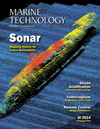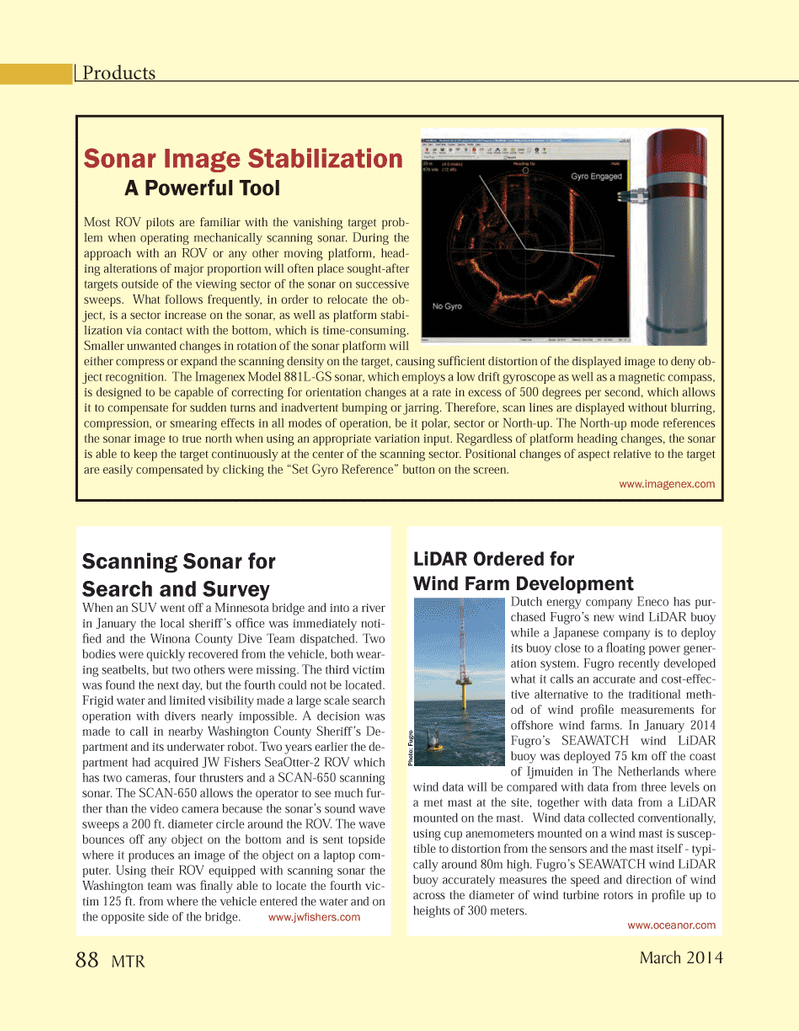
Page 88: of Marine Technology Magazine (March 2014)
Instrumentation: Measurement, Process & Analysis
Read this page in Pdf, Flash or Html5 edition of March 2014 Marine Technology Magazine
Products Sonar Image Stabilization A Powerful Tool Most ROV pilots are familiar with the vanishing target prob- lem when operating mechanically scanning sonar. During the approach with an ROV or any other moving platform, head- ing alterations of major proportion will often place sought-after targets outside of the viewing sector of the sonar on successive sweeps. What follows frequently, in order to relocate the ob- ject, is a sector increase on the sonar, as well as platform stabi- lization via contact with the bottom, which is time-consuming. Smaller unwanted changes in rotation of the sonar platform will either compress or expand the scanning density on the target, causing sufÞ cient distortion of the displayed image to deny ob- ject recognition. The Imagenex Model 881L-GS sonar, which employs a low drift gyroscope as well as a magnetic compass, is designed to be capable of correcting for orientation changes at a rate in excess of 500 degrees per second, which allows it to compensate for sudden turns and inadvertent bumping or jarring. Therefore, scan lines are displayed without blurring, compression, or smearing effects in all modes of operation, be it polar, sector or North-up. The North-up mode references the sonar image to true north when using an appropriate variation input. Regardless of platform heading changes, the sonar is able to keep the target continuously at the center of the scanning sector. Positional changes of aspect relative to the targ et are easily compensated by clicking the ÒSet Gyro ReferenceÓ button on the screen. www.imagenex.com Scanning Sonar for Search and Survey When an SUV went off a Minnesota bridge and into a river in January the local sheriffÕs ofÞ ce was immediately noti- Þ ed and the Winona County Dive Team dispatched. Two bodies were quickly recovered from the vehicle, both wear- ing seatbelts, but two others were missing. The third victim was found the next day, but the fourth could not be located. Frigid water and limited visibility made a large scale search operation with divers nearly impossible. A decision was made to call in nearby Washington County SheriffÕs De- partment and its underwater robot. Two years earlier the de- partment had acquired JW Fishers SeaOtter-2 ROV which has two cameras, four thrusters and a SCAN-650 scanning sonar. The SCAN-650 allows the operator to see much fur- ther than the video camera because the sonarÕs sound wave sweeps a 200 ft. diameter circle around the ROV. The wave bounces off any object on the bottom and is sent topside where it produces an image of the object on a laptop com-puter. Using their ROV equipped with scanning sonar the Washington team was Þ nally able to locate the fourth vic- tim 125 ft. from where the vehicle entered the water and on the opposite side of the bridge. www.jw Þ shers.com LiDAR Ordered for Wind Farm Development Dutch energy company Eneco has pur- chased FugroÕs new wind LiDAR buoy while a Japanese company is to deploy its buoy close to a ß oating power gener- ation system. Fugro recently developed what it calls an accurate and cost-effec- tive alternative to the traditional meth- od of wind proÞ le measurements for offshore wind farms. In January 2014 FugroÕs SEAWATCH wind LiDAR buoy was deployed 75 km off the coast of Ijmuiden in The Netherlands where wind data will be compared with data from three levels on a met mast at the site, together with data from a LiDAR mounted on the mast. Wind data collected conventionally, using cup anemometers mounted on a wind mast is suscep-tible to distortion from the sensors and the mast itself - typi-cally around 80m high. FugroÕs SEAWATCH wind LiDAR buoy accurately measures the speed and direction of wind across the diameter of wind turbine rotors in proÞ le up to heights of 300 meters.www.oceanor.com Photo: Fugro March 2014 88 MTRMTR #2 (82-96).indd 88MTR #2 (82-96).indd 882/22/2014 2:20:06 PM2/22/2014 2:20:06 PM

 87
87

 89
89
